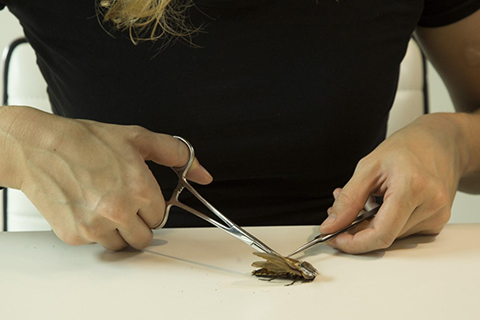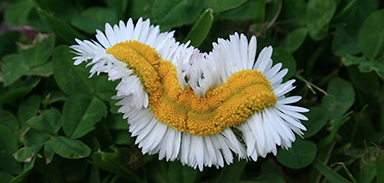The following is a transcript of an artist talk I gave during the 48 Hours Summit at RedLine Contemporary Art Center on Aug 12, 2017. It is about two artworks that are in-progress as of this writing.
by Megan Gafford
Jitterbug and Pushing Daisies were shown as works-in-progress in an exhibition titled LAND TRUST at RedLine Contemporary Art Center in Aug 2017, as part of the 48 HOURS Summit. Photo credit: Wes Magyar
My art is inspired by my passion for science. Science is a way of finding truth that I hold close to my heart in a kind of religious way. Put simply, science is the conviction that we ought to try to prove our ideas wrong, over and over again, until we fail to prove an idea wrong so many times that we can feel some confidence in it after all. And people all over the world are doing the same thing, and taking a crack at other people’s ideas with even greater enthusiasm, so that the result of all this effort is a body of knowledge that enables us to perform miracles.
The scientific method is simple yet revolutionary, a classic example of how some tasks “are easier said than done”, because human nature makes us far more talented at proving ourselves right than wrong. But when we succeed at science, we learn something fundamental about how the world works. As my hero Carl Sagan put it, “We are a way for the cosmos to know itself.”
I also recognize that science is like the Buddhist proverb, "To every person is given the key to the gate of heaven; the same key opens the gate to hell." Science is a completely amoral tool, and it comes with no manual on how to use it to answer the question of where, precisely, scientific progress leads. I spend a lot of time wondering about the blind nature of science, and I use my artwork as a way to ask people to wonder about it with me.
Image from the University of California, Berkeley and Singapore’s Nanyang Technological University, where researchers are studying cyborg flower beetles.
With one of my works-in-progress, titled Jitterbug, I am delving into the implications of how computers have infiltrated the world. My medium is cyborg insects that I am creating by surgically attaching circuit boards to the bugs’ neural pathways, so that I can control their movement. I’m using a Bluetooth signal to transmit a choreographed dance for them to perform. So far I have begun raising colonies of exotic beetle and cockroach species, and I have started practicing the surgical procedure to attach my first generation circuit boards.
Cockroaches are the easiest kind of insect for me to turn into cyborgs. After I finish practicing surgery on the ugly roaches, I plan on designing circuit boards to fit this exotic species of Domino Roaches.
My goal is to synchronize the graceful movements of many insects together in the same dance, so that their terrarium becomes a stage. Learning how to influence an animal’s neurology is a way to gain knowledge of how a mind works, aiding humanity’s perennially pressing concern of understanding how our minds work. We crave comprehension, especially of the seat of consciousness, of the act of comprehending in and of itself. It is an old human need: the ancient Egyptians and Greeks carved the proverb “Know Thyself” onto their temples. Sagan’s famous remarks about being the cosmos knowing itself is just an expanded view of the same wisdom.
My post-operative check-up on the first cockroach I practiced my surgical procedure on. Unfortunately, it died a few days later.
But the doors to heaven and hell are not labelled. And this leads to a broader philosophical question - that is, once humanity understands itself, what will it do with that knowledge? What if the kind of technology that I’m using to create Jitterbug someday leads to human cyborgs that could be hacked and controlled? This kind of question, about the existential implications of Jitterbug, is why my working title for this piece had been Ghost in the Exoskeleton.
Image from North Carolina State University, where researchers are studying cyborg cockroaches.
But that name would have had too narrow a scope, because the ramifications have a wider range, into fields like medicine, search and rescue, and the military. For example, some researchers are trying to create fleets of cockroaches that can be sent into collapsed buildings to locate victims, because finding them is the most difficult part of rescuing them. Or more metaphorically, imagine riding in a driverless car that gets hacked, so that you are forced to move to and fro at another’s whim, just like my cyborg insects.
By attaching an electrode to the insect’s antennae, I can send electrical signals to its neurons to control its movement.
And what about the ethics of body-snatching another species with circuit boards? I believe that developing an accurate theory of mind is a profound existential goal, for which it is worthwhile to compromise the well-being of our insect cousins. In other words, they’re just bugs. And we ought to take care not to anthropomorphize bugs, and consider the lack of moral rules governing insects.
Insects are anesthetized by submerging in ice water
Entomologists don’t know if insects are capable of feeling pain the way humans do, and insects do not demonstrate a sense of self. For example, an injured cricket might smell its own nutritious innards and self-cannibalize because its mind is a rudimentary biological machine with predictable reactions to stimuli. Moreover, if we pretend that insects are capable of sentience, we can imagine that they would be surprised at the kindness I show them.
Parasitic wasp larvae
Wasps, in comparison, are brutal. There are species of wasp that lay eggs in other insects, so that their children burst forth from their hosts to inspire movies like the Aliens franchise. The Glyptapanteles wasp larvae even burrow into caterpillar brains to control its behavior while they devour it alive. But my bugs live in luxurious terrariums. And in part because my studio is a safer place than the wild, I don’t feel guilty about performing cyborg surgery on them, even if it is philosophically messy.
At least 7 of these possible endings results in nuclear war
The story of scientific progress is like a choose-your-own-adventure novel. Which door do you open, what path do you go down? Do you save or annihilate the world? At the beginning of our story, I wonder if humanity knew how many forks there would be in the road and how many accidents we would see along the way. Perhaps the wisdom of using science carefully was not fully understood until after the bomb.
As Susan Sontag put it, there was a "...trauma suffered by everyone in the middle of the 20th century when it became clear that from now on to the end of human history, every person would spend his individual life not only under the threat of individual death, which is certain, but of something almost unsupportable psychologically - collective incineration and extinction which could come any time, virtually without warning." Sontag offers the most somber reminder that this thing that I love - science - is inanimate and unfeeling in return.
My daisy seeds immediately before irradiation by this machine, which is normally used for cancer treatment.
Nuclear fear inspired another of my works-in-progress, titled Pushing Daisies. This past June I dosed hundreds of daisy seeds with radiation to try to mutate them...
Mutant daisies found near the Fukushima Daiichi Nuclear Disaster Site
...like daisies found near the Fukushima Daiichi nuclear disaster site. The Japanese daisies had enlarged and elongated blossoms...
...that resemble caterpillars...
...or conjoined twins.
They reminded me of the infamous daisy ad from Lyndon Johnson's 1964 presidential campaign: a little girl counts daisy petals until she’s drowned out by a voice-over, which counts down to a nuclear explosion that engulfs the TV screen.
Lyndon B. Johnson’s infamous daisy ad from his 1964 presidential campaign
The cartoonish and childlike quality of daisies makes this flower a potent symbol of innocence, or in this case, innocence corrupted.
Not found near Fukushima.
Radiation may not have caused the Japanese daisy deformities, and I don’t know if I’ll succeed in causing mutations myself. If I am able, Pushing Daisies will be an elegant display of my transformed blossoms.
Some of these seedling show irregularities
Right now they are six-week-old seedlings, and I have noticed some irregularities, but it will be months before I find out if these are, in fact, harbingers of mutant blossoms.
A scene from Stanley Kubrick’s
Dr. Strangelove, or: How I Learned to Stop Worrying and Love the Bomb
Even though unlocking the secrets of the atom created the possibility of Mutually Assured Destruction, I’m glad that our scientists did it. Given the option, I would not want to live in an alternative universe where we remained ignorant of the fundamental laws of physics but safer from global politics and nuclear power plant disasters.
The Large Hadron Collider at CERN, a giant particle accelerator for studying fundamental physics and the largest machine ever created by humanity.
The knowledge is just too interesting - the laws of physics were written to describe the most basic inner-workings of reality. It seems to me that my daisies also symbolize how incredible it is that we can learn about something as mysterious as nuclear physics, that we can manipulate the world around us with invisible energy rays. I mean, listen to that - “we can manipulate the world around us with invisible energy rays” - that sounds crazy, yet in practice it has become commonplace. We do this every day, not only in science labs, but with our microwaves, WI-FI signals, and routine dental check ups. Science is a paradox; the good cannot be decoupled from the bad. Both Jitterbug and Pushing Daisies are about this catch-22.

















